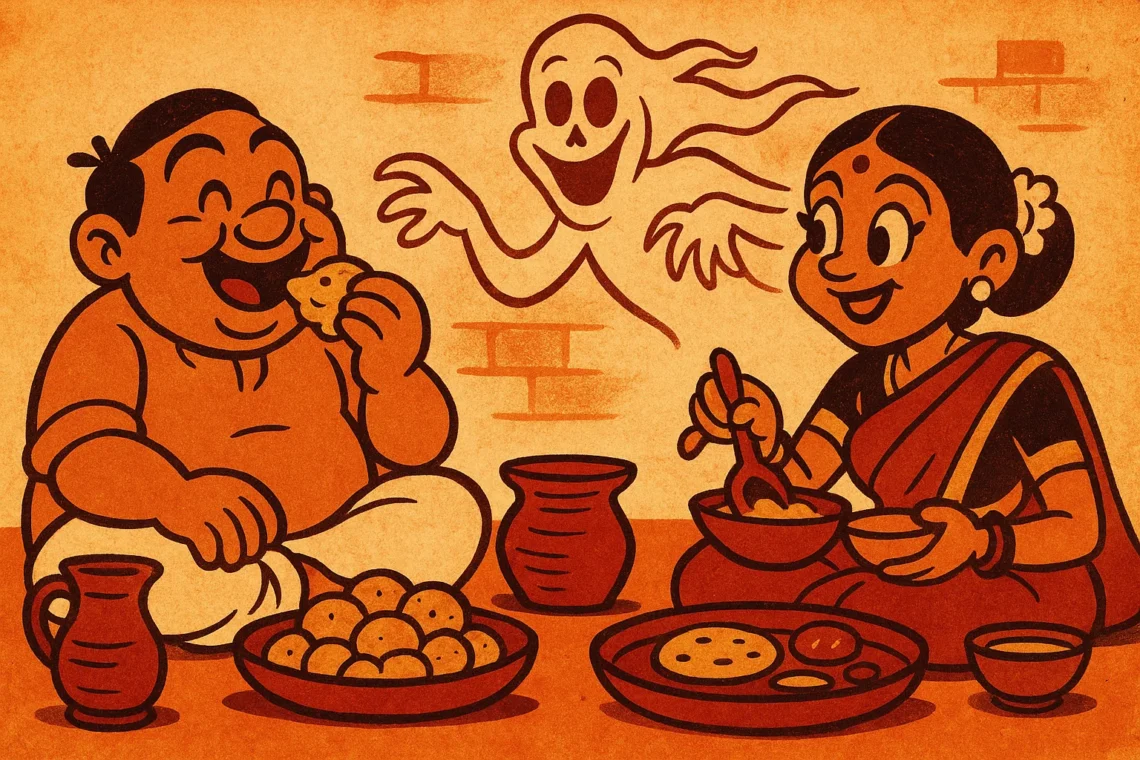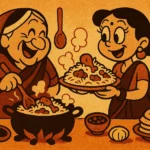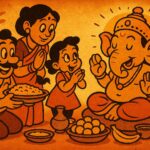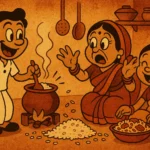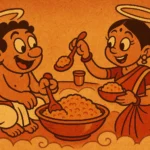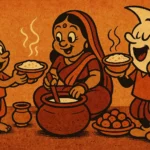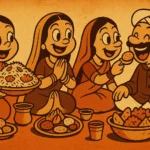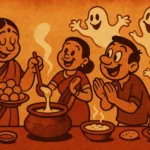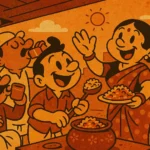As a child growing up in Mumbai, I was always fascinated by the stories my grandmother told me. She had an incredible knack for weaving tales that were both eerie and captivating, tales that blurred the lines between myth and reality. But it wasn’t just the ghosts or the supernatural elements that left an impression on me—it was the food. Yes, you heard that right. In many of her stories, food wasn’t just a backdrop to the haunting—it was an essential part of the ghostly encounters. One story that has stayed with me over the years is about a ghost who, for reasons unknown, always smelled of ghee.
The idea of a ghost with the scent of ghee might sound absurd, but in Indian folklore, food has a very special place. Food isn’t just about satisfying hunger or providing nutrition—it’s about connection, symbolism, and even the supernatural. In many regional horror stories across India, food plays a central role, whether it’s a spectral visit during dinner or a ghostly aroma that lingers long after the haunting has ended. The supernatural and the edible are often intertwined in ways that can be both unsettling and strangely comforting.
The Ghost of Ghee: A Scent That Lingers
In the story my grandmother told me, the ghost who smelled of ghee was no ordinary spirit. She had heard the tale from her own grandmother, who swore it was true. The story went like this: there was once a woman in a small village who cooked the most heavenly meals, and her ghee-laden dishes were said to be irresistible. But after her untimely death, her spirit would return, and those who passed by her house would smell the unmistakable scent of ghee—sweet, rich, and warm—yet the house was always eerily quiet, no one ever saw her, but the smell would linger in the air, making the living uneasy. It was as if the very essence of her cooking was now tied to her spirit, making her presence felt through the food she once prepared so lovingly.
Now, why ghee? Ghee, in Indian cooking, is more than just a cooking medium—it’s revered, almost sacred. It’s used in religious rituals, in offerings, and in the preparation of food meant to honor the divine. It’s also associated with comfort, warmth, and abundance. The scent of ghee can evoke feelings of nostalgia, connection, and care, and it’s not surprising that in this haunting story, the ghost of the woman leaves behind a scent of ghee. It’s a reminder of her life, her love for food, and the comfort she once brought to her family. But now, in death, it becomes a haunting presence, lingering in the air and unsettling those who come too close.
The Power of Food in Horror: A Cultural Lens
Food, especially in Indian culture, is closely tied to both the sacred and the profane. It’s no wonder, then, that food often plays a role in horror stories that deal with the supernatural. In Indian folklore, spirits are often tied to the places they once inhabited, and the foods they prepared or consumed are seen as a part of their essence. Food, in these tales, doesn’t just nourish the body—it becomes a symbol of what remains after death, of things left unresolved. The smell of fresh roti baking in a quiet kitchen, the aroma of spices in the air, and yes, even the scent of ghee, all take on a supernatural quality when tied to the spirit world.
Take the story of the *bhoot* (ghost) who lingers near the rice fields. In many rural Indian horror stories, the rice harvest is often depicted as a time when the dead revisit the living, and the scent of cooked rice can be a signal that something isn’t quite right. The rice, like the ghee, becomes a symbol of sustenance, of life, but also of the spirits that refuse to let go. These tales are not just about ghosts; they are about the intersections between food, life, and death. They reflect the deep cultural understanding that food is never just food—it’s also a bridge to the beyond.
Food as a Vehicle for Memory and Myth
Food, in regional horror stories, often serves as a vehicle for memory. It’s through food that the past is remembered, and through food that the dead continue to influence the living. Think about the *prasad* (offerings) in temples. After a pooja, the food offered to the gods becomes a way to connect with the divine. Similarly, in many horror stories, food symbolizes that bridge between the living and the dead. The ghosts of ancestors might come back to claim their rightful share, or the food might serve as a reminder of unresolved rituals, a haunting call to finish what was once left undone.
In one popular story from Rajasthan, a family left an unfulfilled offering of *dal baati* (a traditional dish) to the deceased after a loved one passed away. As the years went by, the family began to notice strange happenings in their home. At night, they would hear the sound of someone eating. The smell of *dal baati* would drift through the house, even when no one was cooking. It wasn’t until the family finally made the offering, completing the ritual, that the haunting stopped. The story suggests that food, when offered incorrectly or left unfinished, has the power to keep the dead restless, their desires unfulfilled. It’s through food that they are remembered, and it’s only through food that they are at peace.
Bollywood Horror and Food: A Symbol of Fear and Desire
In the realm of Bollywood horror, food continues to play an essential role in setting the tone of the story. Films like *Bhoot* or *Raaz* use food as a medium to express the fear and longing that haunt the characters. In these films, food isn’t just about satisfying hunger—it’s a manifestation of desire, guilt, and supernatural terror. Think about the scenes where the protagonist discovers an untouched plate of food in a haunted house. The food is cold, the smell rancid, but it’s a reminder that something sinister has taken place. Food, in these cases, becomes a metaphor for something unresolved, something that lingers in the air long after the event has passed.
In *Raaz*, for instance, there is a scene where the protagonist is haunted by a ghost who appears whenever food is served in her home. The ghost’s connection to food is symbolic—it represents the past, the unresolved emotional ties, and the deep-rooted guilt that the protagonist must confront. It’s the presence of food, the offering of meals, that brings out the spirit and the drama. Once again, food is used as a metaphor for the emotional weight characters carry—a weight that can only be “released” through confronting the past, through resolving the haunting.
Food as a Bridge Between Worlds
The ghost who smells of ghee is just one example of how food in Indian folklore is tied to the supernatural. Whether it’s the scent of rice, the aroma of freshly baked bread, or the haunting presence of ghee, food serves as a bridge between the living and the dead. In these regional horror stories, food is never just sustenance—it’s a symbol of connection, of unresolved emotions, and of the lingering presence of those who have passed on. And much like the ghost with the scent of ghee, these stories remind us that food is never just what we eat—it’s what we remember, what we honor, and sometimes, what we fear.
Born in Mumbai, now stir-frying feelings in Texas. Writes about food, memory, and the messy magic in between — mostly to stay hungry, sometimes just to stay sane.

